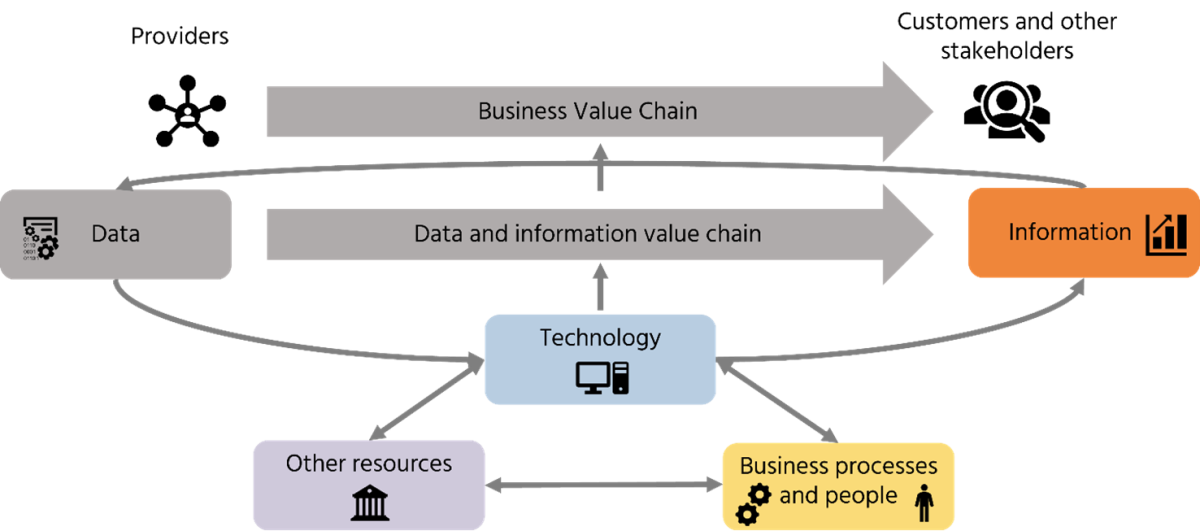Even if last six years I have been specialized in Data management, I still follow (thanks...

FP&A and data management are strongly interconnected business capabilities. Years ago, I switched my finance career to a data management one. However, during all these years, data management for financial data has remained my key focus.
In this blog, I want to:
- Demonstrate the relationship between FP&A and data management.
- Review the data strategy goals and challenges with its implementation.
- Highlight the role of FP&A in implementing a company’s data strategy.
FP&A and Data Management in Delivering Business Value
All companies have one common goal: to survive in the long term. They do it by delivering value to their stakeholders, internal and external. They deliver value along business value chains, as shown in Figure 1.

Figure 1: The Role of Data in Business
Data and information play a significant role in supporting the business value chain. All business stakeholders require information to make relevant decisions.
The key business value proposition of FP&A is to provide trustful timely information and support decision-making at various organisational levels. FP&A does this by applying an integrated approach to combine and link a company’s plans and forecasts between these levels. Integrated data is a source for FP&A’s daily activities, and integrated information is its key product.
Data nanagement’s value proposition is safeguarding and getting value from data assets. Data management does it by enabling data and information value chains. These chains transform raw data into meaningful information and deliver information to all business stakeholders, including FP&A.
Data and information unite FP&A and data management. Data management enables data sourcing, integration, transformation and delivery. FP&A finds meaning in the delivered information and supports a company’s management in decision-making.
In this sense, data management must enable FP&A to perform its tasks by providing correct, trustful and timely data and information. FP&A is one of the key data management stakeholders. A data strategy must specify this relation.
Data Strategy: Goals and Challenges
A data strategy is a company’s long-term vision on:
- the role of data and the value it can deliver within a defined business model,
- data management organisation,
- data handling practices.
The data strategy is one of the company’s functional strategies that must be aligned with the overall business strategy. Every business unit, including FP&A, must participate in establishing this strategy by articulating its data needs. Data management summarises all business needs into a feasible action plan and ensures its implementation.
Companies face several challenges in realising the data strategy:
- Lack of C-suite support and resources.
- Data management is a mandatory foundation for any other data-related initiative, such as digital transformation, AI/ML, advanced analytics, etc. Companies often need to establish a data management function before starting these initiatives.
- Underestimation of the need to set up multiple data management capabilities as business functions
FP&A is one of the key stakeholders of data management. How can FP&A’s top management help resolve these challenges?
The Role of FP&A in Implementing Data Strategy
FP&A’s management must clearly understand its role in improving the situation with data and take several steps.
1. Sponsor a data management initiative.
FP&A is one of the most influential data stakeholders in a company. FP&A professionals experience the most significant pain if something goes wrong with data. If FP&A professionals lack detailed, timely and correct data for integrated planning, a company can hardly make the right strategic and tactical decisions. It brings the FP&A leader to a very powerful position. FP&A must sponsor a data management initiative and promote its recognition as one of a company’s strategic initiatives. Only in this case can the company find enough resources to build a solid data management foundation.
2. Identify the scope of data required for the FP&A tasks.
Based on my experience, 80% of data circulating within a company can be required to realise integrated FP&A tasks. Customer, product, marketing, sales and other operational data are examples. However, a company can’t improve the situation with all this data in the short term. FP&A must define the most critical information needed for decision-making. Delivering one strategic KPI can require dozens and hundreds of data elements to be discovered, sourced, transformed and integrated. One of the examples from my practice is delivering the aggregated accrued interest in a statutory report requires 47 source data elements. Often, multiple data chains are involved in delivering this KPI. Defining critical data and data flows allows data management-related tasks to be prioritised, making this initiative feasible.
3. Assist in performing data management tasks.
FP&A is a data user and must refrain from tasks like data collection and integration that require data management professionals. However, many FP&A professionals still perform these tasks. Poor data management forces FP&A professionals to perform lower-level data sourcing and cleansing tasks instead of analysing information. When a company sets a properly functioning data management, FP&A professionals should perform several tasks related to data management. They are subject matter experts who have much knowledge about data and information. FP&A professionals must clearly state their requirements regarding information and its quality. They also must assist in describing data by providing data and information definitions. They should actively participate in validating data quality and resolving data issues.
Only the combined efforts of multiple business units and professionals can improve the situation in relation to data in a company.
Conclusions and Recommendations
1. Data management and FP&A have a lot in common: they deliver business value by providing data and information for decision-making at various organisational levels. Data Management enables data sourcing, integration, transformation and delivery. FP&A finds meaning in the delivered information and supports a company’s management in decision-making.
2. A data strategy is a company’s long-term vision on the role of data as one of the company’s assets, the organisation of a data management function and data handling practices. The data strategy must consider the needs of various business stakeholders, including FP&A.
3. FP&A is one of the most influential and important data stakeholders. FP&A management must play a leading role in establishing a formal data management function and sponsoring data-related initiatives.
4. Solid data management is a mandatory foundation for multiple data-related initiatives.
5. FP&A professionals are subject matter experts who should perform several important data management-related tasks like assisting in building a business glossary and data models, defining requirements for information and data quality and validating data quality measuring results.
This article was first published on the SAP Blog.
Discover expert insights on data strategy, governance, and implementation at Data Crossroads and Data Crossroads
Academy.
Subscribe to
FP&A Trends Digest

We will regularly update you on the latest trends and developments in FP&A. Take the opportunity to have articles written by finance thought leaders delivered directly to your inbox; watch compelling webinars; connect with like-minded professionals; and become a part of our global community.




